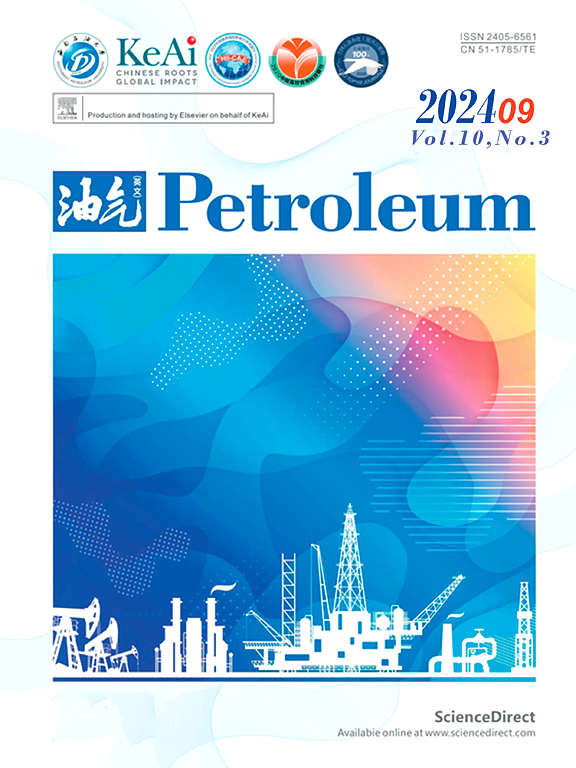A novel approach to modeling breakdown pressure dynamics using machine learning
IF 3.5
Q2 ENERGY & FUELS
引用次数: 0
Abstract
This study presents a novel machine learning (ML)-based approach for predicting breakdown pressure (BP) in hydraulic fracturing using experimental data. Unlike traditional analytical models that rely on simplified assumptions, ML models can capture complex nonlinear relationships between BP and its influencing factors. However, a key limitation in BP prediction stems from dataset constraints, particularly the scale differences between experimental setups and real-world formations. To mitigate these limitations, this research utilizes a unique dataset of 144 BP data points, incorporating various rock mechanical properties, injection parameters, and fluid properties. Additionally, a separate analysis of pressurization rate, based on 32 additional experimental data points, was conducted to better understand its effect on fracture initiation—an aspect often overlooked in ML-based studies. The dataset includes critical parameters such as injection rate, confining pressure, tensile strength, Young's modulus, permeability, unconfined compressive strength, Poisson's ratio, porosity, wellbore radius, and fracture geometry ratio. Five ML models—LightGBM, CatBoost, XGBoost, Kolmogorov-Arnold Network (KAN), and TabNet—were trained and evaluated. TabNet achieved the highest predictive performance (R2 = 0.94) due to its attention-based feature selection and deep-learning-based representation learning. Model performance was assessed using mean absolute error (MAE) and mean squared error (MSE) to ensure robustness. To further enhance model interpretability, SHapley Additive exPlanations (SHAP) and TabNet's attention mechanism were used to explicitly assess feature importance, providing insights into the relative influence of different parameters on BP predictions. Additionally, advanced feature-handling techniques were employed to address categorical variables automatically, ensuring minimal preprocessing bias. The findings demonstrate the scalability of ML models for BP prediction using experimental data, reducing reliance on costly and time-consuming laboratory testing. By incorporating advanced interpretability techniques, systematic pressurization rate analysis, and robust ML architectures, this research provides a more accurate, data-driven approach for optimizing hydraulic fracturing designs.
使用机器学习建模击穿压力动力学的新方法
该研究提出了一种基于机器学习(ML)的新方法,利用实验数据预测水力压裂破裂压力(BP)。与传统的依赖于简化假设的分析模型不同,ML模型可以捕捉BP与其影响因素之间复杂的非线性关系。然而,BP预测的一个关键限制来自数据集的限制,特别是实验设置与实际地层之间的规模差异。为了克服这些限制,该研究利用了144 BP数据点的独特数据集,结合了各种岩石力学特性、注入参数和流体特性。此外,基于32个额外的实验数据点,对加压速率进行了单独的分析,以更好地了解其对裂缝起裂的影响,这是基于ml的研究中经常忽略的一个方面。该数据集包括注入速率、围压、抗拉强度、杨氏模量、渗透率、无侧限抗压强度、泊松比、孔隙度、井筒半径和裂缝几何比等关键参数。对lightgbm、CatBoost、XGBoost、Kolmogorov-Arnold Network (KAN)和tabnet这5个ML模型进行了训练和评估。TabNet由于其基于注意力的特征选择和基于深度学习的表征学习,获得了最高的预测性能(R2 = 0.94)。使用平均绝对误差(MAE)和均方误差(MSE)评估模型性能以确保稳健性。为了进一步提高模型的可解释性,我们使用SHapley加性解释(SHAP)和TabNet的注意机制来明确评估特征的重要性,从而深入了解不同参数对BP预测的相对影响。此外,采用先进的特征处理技术来自动处理分类变量,确保最小的预处理偏差。研究结果表明,使用实验数据进行BP预测的ML模型具有可扩展性,减少了对昂贵且耗时的实验室测试的依赖。通过结合先进的可解释性技术、系统的加压速率分析和强大的机器学习架构,该研究为优化水力压裂设计提供了更准确、数据驱动的方法。
本文章由计算机程序翻译,如有差异,请以英文原文为准。
求助全文
约1分钟内获得全文
求助全文
来源期刊

Petroleum
Earth and Planetary Sciences-Geology
CiteScore
9.20
自引率
0.00%
发文量
76
审稿时长
124 days
期刊介绍:
Examples of appropriate topical areas that will be considered include the following: 1.comprehensive research on oil and gas reservoir (reservoir geology): -geological basis of oil and gas reservoirs -reservoir geochemistry -reservoir formation mechanism -reservoir identification methods and techniques 2.kinetics of oil and gas basins and analyses of potential oil and gas resources: -fine description factors of hydrocarbon accumulation -mechanism analysis on recovery and dynamic accumulation process -relationship between accumulation factors and the accumulation process -analysis of oil and gas potential resource 3.theories and methods for complex reservoir geophysical prospecting: -geophysical basis of deep geologic structures and background of hydrocarbon occurrence -geophysical prediction of deep and complex reservoirs -physical test analyses and numerical simulations of reservoir rocks -anisotropic medium seismic imaging theory and new technology for multiwave seismic exploration -o theories and methods for reservoir fluid geophysical identification and prediction 4.theories, methods, technology, and design for complex reservoir development: -reservoir percolation theory and application technology -field development theories and methods -theory and technology for enhancing recovery efficiency 5.working liquid for oil and gas wells and reservoir protection technology: -working chemicals and mechanics for oil and gas wells -reservoir protection technology 6.new techniques and technologies for oil and gas drilling and production: -under-balanced drilling/gas drilling -special-track well drilling -cementing and completion of oil and gas wells -engineering safety applications for oil and gas wells -new technology of fracture acidizing
 求助内容:
求助内容: 应助结果提醒方式:
应助结果提醒方式:


